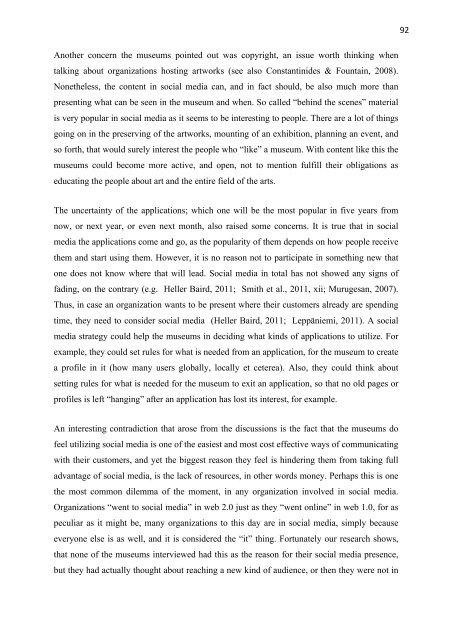Is there more to it than posting a status update?
Is there more to it than posting a status update?
Is there more to it than posting a status update?
Create successful ePaper yourself
Turn your PDF publications into a flip-book with our unique Google optimized e-Paper software.
Another concern the museums pointed out was copyright, an issue worth thinking when<br />
talking about organizations hosting artworks (see also Constantinides & Fountain, 2008).<br />
Nonetheless, the content in social media can, and in fact should, be also much <strong>more</strong> <strong>than</strong><br />
presenting what can be seen in the museum and when. So called “behind the scenes” material<br />
is very popular in social media as <strong>it</strong> seems <strong>to</strong> be interesting <strong>to</strong> people. There are a lot of things<br />
going on in the preserving of the artworks, mounting of an exhib<strong>it</strong>ion, planning an event, and<br />
so forth, that would surely interest the people who “like” a museum. W<strong>it</strong>h content like this the<br />
museums could become <strong>more</strong> active, and open, not <strong>to</strong> mention fulfill their obligations as<br />
educating the people about art and the entire field of the arts.<br />
The uncertainty of the applications; which one will be the most popular in five years from<br />
now, or next year, or even next month, also raised some concerns. It is true that in social<br />
media the applications come and go, as the popular<strong>it</strong>y of them depends on how people receive<br />
them and start using them. However, <strong>it</strong> is no reason not <strong>to</strong> participate in something new that<br />
one does not know where that will lead. Social media in <strong>to</strong>tal has not showed any signs of<br />
fading, on the contrary (e.g. Heller Baird, 2011; Sm<strong>it</strong>h et al., 2011, xii; Murugesan, 2007).<br />
Thus, in case an organization wants <strong>to</strong> be present where their cus<strong>to</strong>mers already are spending<br />
time, they need <strong>to</strong> consider social media (Heller Baird, 2011; Leppäniemi, 2011). A social<br />
media strategy could help the museums in deciding what kinds of applications <strong>to</strong> utilize. For<br />
example, they could set rules for what is needed from an application, for the museum <strong>to</strong> create<br />
a profile in <strong>it</strong> (how many users globally, locally et ceterea). Also, they could think about<br />
setting rules for what is needed for the museum <strong>to</strong> ex<strong>it</strong> an application, so that no old pages or<br />
profiles is left “hanging” after an application has lost <strong>it</strong>s interest, for example.<br />
An interesting contradiction that arose from the discussions is the fact that the museums do<br />
feel utilizing social media is one of the easiest and most cost effective ways of communicating<br />
w<strong>it</strong>h their cus<strong>to</strong>mers, and yet the biggest reason they feel is hindering them from taking full<br />
advantage of social media, is the lack of resources, in other words money. Perhaps this is one<br />
the most common dilemma of the moment, in any organization involved in social media.<br />
Organizations “went <strong>to</strong> social media” in web 2.0 just as they “went online” in web 1.0, for as<br />
peculiar as <strong>it</strong> might be, many organizations <strong>to</strong> this day are in social media, simply because<br />
everyone else is as well, and <strong>it</strong> is considered the “<strong>it</strong>” thing. Fortunately our research shows,<br />
that none of the museums interviewed had this as the reason for their social media presence,<br />
but they had actually thought about reaching a new kind of audience, or then they were not in<br />
92















